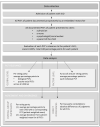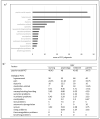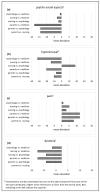Relevance of Potential Contributing Factors for the Development and Maintenance of Irritability of Unknown Origin in Pediatric Palliative Care
- PMID: 38002817
- PMCID: PMC10670487
- DOI: 10.3390/children10111726
Relevance of Potential Contributing Factors for the Development and Maintenance of Irritability of Unknown Origin in Pediatric Palliative Care
Abstract
Potential contributing factors (PCFs) for irritability of an unknown origin (IUO) in children with neurological conditions are identifiable through structured diagnostics. Uncertainty exists regarding the actual relevance of identified PCFs to IUO. Assessments from parents as well as nursing, psycho-social, and medical professionals were used to determine the contribution of different PCFs in the development and maintenance of IUO. For this, individual PCFs of N = 22 inpatient children with IUO were presented to four raters. Descriptive statistics, Kruskal-Wallis tests, and Krippendorff's alpha were used to determine which PCFs were most relevant to explain IUO and rater agreement. Psycho-social aspects (44.7%), hyperarousal (47.2%), pain (24.6%), and dystonia (18.1%) were identified as the most relevant PCFs for IUO. Descriptively, physicians' relevance rating regarding psycho-social aspects, hyperarousal, and dystonia deviated the most from the overall group rating. All professional raters considered psycho-social aspects to be more relevant than did parents. Parents rated pain as more relevant than the other raters. Kruskal-Wallis tests showed no significant differences between relevance ratings (H = 7.42, p = 0.059) or the four parties' deviations (H = 3.32, p = 0.344). A direct comparison of the six two-party constellations showed that across all factors, agreement was weak to moderate. The highest agreement was between physicians and nurses (α = 0.70), and the lowest was between nurses and psycho-social experts (α = 0.61). Understanding which psycho-social and various biological PCFs are significant for IUO can facilitate more targeted and individualized pediatric palliative care for affected patients.
Keywords: children; irritability; palliative care; pediatrics.
Conflict of interest statement
The authors declare no conflict of interest.
Figures



Similar articles
-
Potential Contributing Factors for Irritability of Unknown Origin in Pediatric Palliative Care.J Pain Symptom Manage. 2022 Aug;64(2):156-167. doi: 10.1016/j.jpainsymman.2022.04.168. Epub 2022 Apr 14. J Pain Symptom Manage. 2022. PMID: 35430284
-
Higher diagnostic yield of 18F-FDG PET in inflammation of unknown origin compared to fever of unknown origin.Eur J Intern Med. 2023 Apr;110:71-76. doi: 10.1016/j.ejim.2023.01.025. Epub 2023 Feb 2. Eur J Intern Med. 2023. PMID: 36739216
-
Interrater reliability estimators tested against true interrater reliabilities.BMC Med Res Methodol. 2022 Aug 29;22(1):232. doi: 10.1186/s12874-022-01707-5. BMC Med Res Methodol. 2022. PMID: 36038846 Free PMC article.
-
Telephone interventions for symptom management in adults with cancer.Cochrane Database Syst Rev. 2020 Jun 2;6(6):CD007568. doi: 10.1002/14651858.CD007568.pub2. Cochrane Database Syst Rev. 2020. PMID: 32483832 Free PMC article.
-
Identifying research priorities around psycho-cognitive and social factors for recovery from hip fractures: An international decision-making process.Injury. 2018 Aug;49(8):1466-1472. doi: 10.1016/j.injury.2018.04.017. Epub 2018 Apr 20. Injury. 2018. PMID: 29739655 Review.
Cited by
-
Insights From the International Consensus on Neuro-Irritability in Pediatric Palliative Care: Expanding the Known, Challenging the Unknown.Neurol Clin Pract. 2025 Oct;15(5):e200525. doi: 10.1212/CPJ.0000000000200525. Epub 2025 Aug 11. Neurol Clin Pract. 2025. PMID: 40799357 Free PMC article.
References
LinkOut - more resources
Full Text Sources

